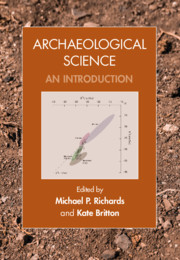Book contents
- Archaeological Science
- Archaeological Science
- Copyright page
- Contents
- Figures
- Tables
- Contributors
- Acknowledgements
- Part I Introduction
- Part II Biomolecular Archaeology
- Part III Bioarchaeology
- Part IV Environmental Archaeology
- 10 Vertebrate Zooarchaeology
- 11 Invertebrate Zooarchaeology
- 12 Palaeoethnobotany
- 13 Geoarchaeology
- Part V Materials Analysis
- Part VI Absolute Dating Methods
- Index
- References
10 - Vertebrate Zooarchaeology
from Part IV - Environmental Archaeology
Published online by Cambridge University Press: 19 December 2019
- Archaeological Science
- Archaeological Science
- Copyright page
- Contents
- Figures
- Tables
- Contributors
- Acknowledgements
- Part I Introduction
- Part II Biomolecular Archaeology
- Part III Bioarchaeology
- Part IV Environmental Archaeology
- 10 Vertebrate Zooarchaeology
- 11 Invertebrate Zooarchaeology
- 12 Palaeoethnobotany
- 13 Geoarchaeology
- Part V Materials Analysis
- Part VI Absolute Dating Methods
- Index
- References
Summary
Our relationship with animals has a long and complex history, one that is as important today as in the past. However, while most of us interact with domesticated animals (and their by-products) daily, we rarely give this complex relationship (or its history) a second thought. We put milk or yoghurt on our breakfast cereal, eat cheese (and perhaps ham) sandwiches as snacks and consider roast chicken as a treat for Sunday lunch. Most of us wear shoes or other clothes made from animal products and sleep under down duvets. We take our dogs for walks, stroke (or chase away from our gardens) the neighbour’s cat (whilst likely getting bitten by its fleas!), and – if we’re very lucky – ride horses for pleasure. Our interactions with animals are not, however, always positive. Whilst we might encourage songbirds to our gardens by feeding them, we’re less keen on sharing our living spaces with those animals considered pests, who can spread disease and (if given the opportunity) spoil our stored foods.
- Type
- Chapter
- Information
- Archaeological ScienceAn Introduction, pp. 215 - 232Publisher: Cambridge University PressPrint publication year: 2020



